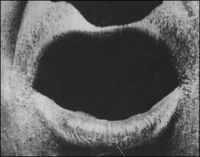Meaning (philosophy)
From The Art and Popular Culture Encyclopedia

Illustration: a close-up of a mouth in the film The Big Swallow (1901)
|
Related e |
|
Featured: |
The nature of meaning, its definition, elements, and types, was discussed by philosophers Aristotle, Augustine, and Aquinas. According to them 'meaning is a relationship between two sorts of things: signs and the kinds of things they mean (intend, express or signify)'. One term in the relationship of meaning necessarily causes something else to come to the mind. In other words: 'a sign is defined as an entity that indicates another entity to some agent for some purpose'.
The types of meanings vary according to the types of the thing that is being represented. Namely:
- There are the things in the world, which might have meaning;
- There are things in the world that are also signs of other things in the world, and so, are always meaningful (i.e., natural signs of the physical world and ideas within the mind);
- There are things that are always necessarily meaningful, such as words, and other nonverbal symbols.
All subsequent inquiries emphasize some particular perspectives within the general AAA framework.
The major contemporary positions of meaning come under the following partial definitions of meaning:
- Psychological theories, exhausted by notions of thought, intention, or understanding;
- Logical theories, involving notions such as intension, cognitive content, or sense, along with extension, reference, or denotation;
- Message, content, information, or communication;
- Truth conditions;
- Usage, and the instructions for usage; and
- Measurement, computation, or operation.
See also


